YouTube Disclaimers
Did you know that 6 out of 10 people prefer watching online video platforms over live TV? YouTube is the third-most visited website in the world, behind only Google and Facebook. Every single day, people watch more than a billion hours of YouTube videos.
But just like anything else you publish, there are certain disclaimers you need to keep your viewers happy, to keep the Federal Trade Commission (FTC) happy, and to keep you out of a legal mess.
What is a Disclaimer?
A disclaimer is a statement that denies responsibility. By using one, you're disclaiming legal liability if something goes wrong. Simply put, if something negative happens after someone uses your product, pays for your service, or takes your advice, a good disclaimer can prevent them from taking legal action against you.
A common example of a disclaimer can be found on WebMD's My Medicine Page:
 v
v
WebMD wants to make it clear that the information they've provided isn't meant to replace a trip to your doctor. Plus, they point out that there could be certain drug interactions that aren't mentioned on their website. They also come right out and say that there's "no guarantee" that their content is "accurate and up-to-date."
In other words, if you make major medical decisions based solely on what it says on WebMD's My Medicine page, WebMD isn't responsible if something bad happens to you as a result.
So how does this apply to your YouTube Channel?
Because you're publishing videos that could be seen by millions of people all over the world and you may need some disclaimers to protect yourself. Without the necessary disclaimers, you could be dragged into court for lengthy, expensive, and stressful legal claims.
Aside from legal action from viewers, you can end up in hot water with the Federal Trade Commission (FTC) if your YouTube channel doesn't have the proper disclaimers. That's definitely a headache you don't want!
Your YouTube channel isn't any different from your blog or a guest article that you publish. People are going to take the information in your videos just as seriously as they would in a blog post. In fact, some people may give your YouTube videos even more credibility because they can see and hear you.
What Disclaimers to Include on your YouTube Channel
The answer to this question depends mostly on what kind of videos you're publishing.
For example, if your channel is chock full of videos that talk about Lupus, you'll need a medical disclaimer like the one we looked at from WebMD. Or if you're using your YouTube channel to market your affiliate products, you'll need a disclaimer that tells viewers you'll receive a commission if they make a purchase through one of your links.
Here are the most common disclaimers that you'll see on YouTube channels.
Professional liability disclaimers
The WebMD disclaimer we discussed above is a great example of a professional liability disclaimer. These disclaimers tell your viewers that the information you're giving them isn't designed to replace professional input.
A good professional liability disclaimer will explain that no professional relationship is being created by someone watching your video. For example, if you offer legal advice on your YouTube channel, viewers don't become your clients just because they saw your advice. There is no attorney-client privilege between you, and you do not have any professional obligations to them.
Here's how one attorney approached her professional liability disclaimer:
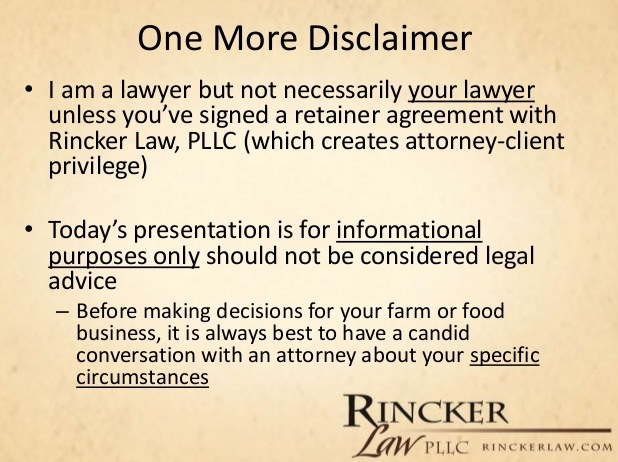
She makes is clear that she is a lawyer, but she isn't YOUR lawyer. Plus, she points out that her presentation is "for informational purposes only." In other words, don't make any major decisions based on her presentation alone. If you want, you can use her information as a supplement to the information you get from a retained lawyer who knows the specifics of your situation.
And if you're NOT a professional in the area you're discussing in your videos, it's vital to mention that in your disclaimer.
Here's a good way to do it:
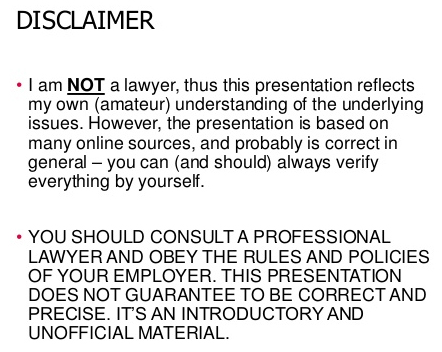
Not only does this disclaimer make it clear that the author isn't a lawyer, it also instructs readers to "CONSULT A PROFESSIONAL LAWYER." Thanks to the simple language, the capital letters, and the bolding, it would be impossible to miss this disclaimer, which is exactly how the FTC likes it.
Use at your own risk disclaimers
You've likely seen "Use at Your Own Risk" signs at the playground, the laundromat, and the gym, but there are plenty of use at your own risk disclaimers floating around on YouTube, too.
The meaning behind all of these disclaimers is the same. You know that proceeding comes with some degree of risk, and if something goes wrong, the owner/publisher isn't legally responsible for it. If you get injured at the playground, ruin a shirt at the laundromat, pull a muscle at the gym, or make decisions based solely off of YouTube videos, you're on your own.
This YouTube video shows you how to troubleshoot problems with your wireless headset, and it comes with a clear disclaimer at the end:

Even though you've just watched a video with step-by-step instructions, the publisher of this video wants you to know that he isn't liable if the process doesn't work for you.
The good part about having this disclaimer as part of the video is that it will go anywhere the video goes. So if someone decides to embed this video on their website, the disclaimer will still show at the end.
Other YouTube publishers prefer to put their use at your own risk disclaimers in the description box so that viewers can read it before they watch the video. However, if these videos get embedded anywhere, those viewers won't see the disclaimer because YouTube's description box doesn't transfer over.
Here's an example of what we're talking about. The description box for this YouTube video contains a use at your own risk disclaimer at the bottom:

The publisher of this YouTube video not only says that you're using the workout information at your own risk, but he threw in a professional liability disclaimer, too. He very clearly states that the information is "of a general nature and is furnished only for educational/entertainment purposes."
Combine both disclaimers together, and this publisher has a solid argument if anyone tries to file a legal claim against him.
Fair use disclaimers
Under US copyright law, there is one exception to using copyrighted content without the owner's consent -- fair use. Fair use means that you're only using a small portion of the copyrighted content and you're not pulling any profits away from the copyright owner by doing so.
YouTube channels are chock full of fair use disclaimers. Typically, they'll show up at the very beginning of a video, like this one:
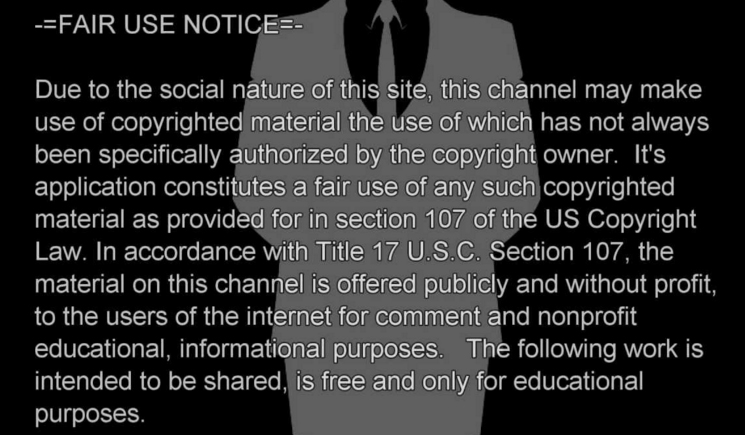
Here's another example that's worded a little differently:
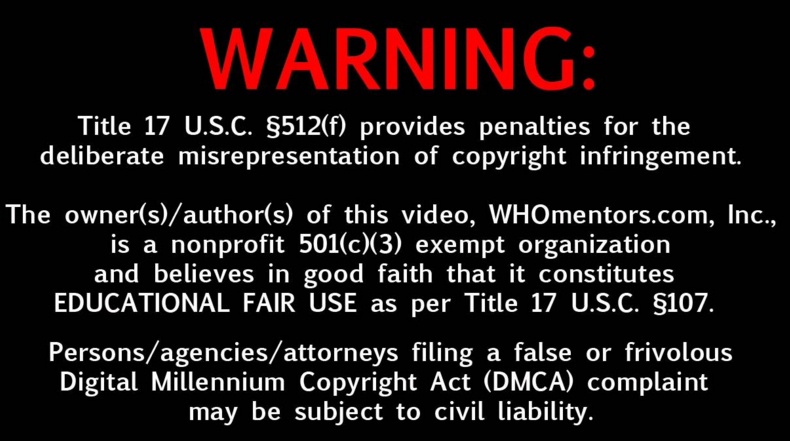
This disclaimer starts by citing the specific US statute that addresses fair use.
A word of warning: Using a fair use disclaimer doesn't automatically mean that your use of the content falls under the exception. Only a court can determine if you're protected by fair use.
One good thing, though, is that YouTube offers Fair Use Protection. If a copyright owner claims that a specific video is violating his copyright, YouTube doesn't blindly take the video down. Instead, they'll ask the rightsholder if he analyzed the video in question to see if it really violates the fair use exception. If it does, YouTube may work with the video publisher to edit the video so that it doesn't violate anyone's copyright.
No guarantee disclaimers
You may be very diligent about updating your YouTube channel, but everything changes over time. And depending on what industry you're in, changes can occur so frequently that you can't possibly have all of the latest news and developments on your channel.
That's why it's so important to have a disclaimer that says you don't guarantee that the information in your videos is accurate and up-to-date. Here's an example from a website that provides advice about financial commodities and brokers:
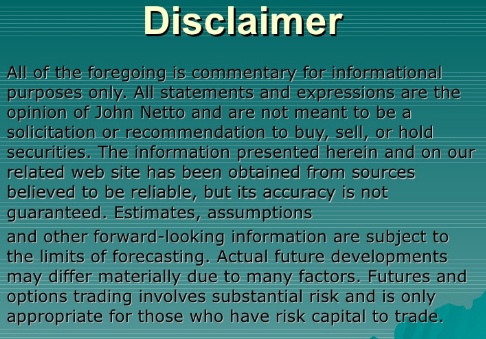
Because the financial world can change so quickly, this disclaimer is vital. With it, readers and viewers know that the information they're getting may not be accurate right at this very moment. Without this disclaimer, people may blindly follow outdated advice.
There's another instance where you need to include a no guarantee disclaimer: When you're providing instructions and/or advice that generated big results for you. Here's one from a presentation by CAN SLIM Investing:

This disclaimer points out that "past performance is no indication or guarantee of future results." This is vital when your YouTube videos include things like investment advice or weight loss tips. After all, just because something worked well for you doesn't mean it will work well for everyone else who's watching. You'd be doing your viewers a huge disservice if you didn't point that out.
Third party disclaimers
Tregaskiss has a specific YouTube disclaimer page right on its website. Included in it, you'll find a disclaimer that applies to a variety of third parties:

This disclaimer includes everything from comments on videos, to the advertisers that may pop up on their channel, to message boards that talk about the content in their videos. In other words, if it doesn't come straight from their mouths, they're not responsible for it.
It takes a lot of time to create and promote great YouTube videos, so the last thing you need is for a missing disclaimer to wipe out all of that hard work. Now that you know how disclaimers work on YouTube, you're ready to give yourself the ultimate protection by including some of the ones we covered, and in some of the ways we covered.